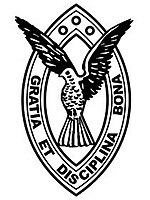| Columba College Coláiste Choilm | |
|---|---|
 | |
| Address | |
| 399 Highgate, Dunedin | |
| Coordinates | 45°51′47″S 170°29′40″E / 45.863125°S 170.494375°E / -45.863125; 170.494375 |
| Information | |
| Type | State-integrated, Day & Boarding (secondary) |
| Motto | Latin: Gratia et Disciplina Bona (With Grace and Good Discipline) |
| Established | 1915; 110 years ago |
| Ministry of Education Institution no. | 386 |
| Principal | Charissa Nicol (2022–present) |
| Years offered | 1–13 |
| Gender | co-education primary (Year 1–6); single sex girls secondary (Year 7–13) |
| School roll | 590 (November 2024) |
| Socio-economic decile | 10Z |
| Website | columbacollege.school.nz |
Columba College (Irish: Coláiste Choilm) is an integrated Presbyterian school in Roslyn, Dunedin, New Zealand. The roll is made up of pupils of all ages. The majority of pupils are in the girls' secondary, day and boarding school, but there is also a primary school for boys and girls in years 1–6.
History

Columba College was established in 1915 by the Presbyterian Church of New Zealand as a private day and boarding school for girls with co-educational primary classes. The Rev'd Alexander Whyte was a key figure in the foundation of Columba College, through his vision for a Presbyterian girls' school.
Columba College was created from two earlier Dunedin girls' schools, Girton College and Braemar House. Girton College had been founded in 1886 by the first woman graduate of the University of Otago, Caroline Freeman, who sold it to Frances Ross in 1891. Ross then purchased Braemar House and combined it with Girton College.
Frances Ross was appointed by the Presbytery of Dunedin as the first Head Mistress of the newly created Columba College in 1914. The schools moved to the current site at Bishopscourt, purchased from the first Anglican bishop for Otago and Southland, Bishop Nevill. The large house there had been designed by William Mason and built in 1872.
Whereas most church schools took a conservative view of girls' education, Columba built on the traditions of Girton College. High educational standards were set, while due attention was given to music, physical training, domestic science and, of course, religious instruction. The differing abilities and aspirations of the pupils were acknowledged and fostered. Ross expected a great deal from her girls and was not disappointed. Columba girls took prizes, scholarships and degrees at university and made their mark in a range of occupations.
Grace Mackintosh was a Scottish-born teacher who became the principal in 1930. She appeared to be religious. She had difficulty in coping with the climate and the job. She suffered with arthritis and making routine decisions. She left after three years when she was appointed at the head of Presbyterian Ladies' College, Pymble.
Columba College was integrated as a composite school under the terms of the Private Schools' Integration Act effective 31 January 1994.
Boarding facilities
Attached to the school are boarding facilities, catering for approximately 110 students, both domestic and international from years 7 to 13. Students live in one of two on-campus buildings, Katharine Buchan House or Bishopscourt.
Notable alumnae
Main category: People educated at Columba College- Frances Hodgkins – artist, at Braemar House
- Cilla McQueen – poet
- Greta Stevenson – botanist
Notable staff
Frances Ross – New Zealand school principal
See also
References
- ^ "The Columba Story". Columba College. Retrieved 2 November 2021.
- "New Zealand Schools Directory". New Zealand Ministry of Education. Retrieved 1 January 2025.
- "Decile Change 2014 to 2015 for State & State Integrated Schools". Ministry of Education. Archived from the original on 24 January 2015. Retrieved 12 February 2015.
- Ross, Angus. "Frances Jane Ross". Dictionary of New Zealand Biography. Ministry for Culture and Heritage. Retrieved 7 May 2021.
- Sherington, G. E., "Grace Mackintosh (1890–1954)", Australian Dictionary of Biography, Canberra: National Centre of Biography, Australian National University, retrieved 7 January 2024
- "Integration agreements for state integrated schools: C to E". Education in New Zealand. Archived from the original on 13 September 2019. Retrieved 7 April 2021.
- "New Zealand Book Council". 13 March 2016. Archived from the original on 13 March 2016. Retrieved 17 September 2023.
- Taonga, New Zealand Ministry for Culture and Heritage Te Manatu. "Stevenson, Greta Barbara". teara.govt.nz. Retrieved 5 December 2022.